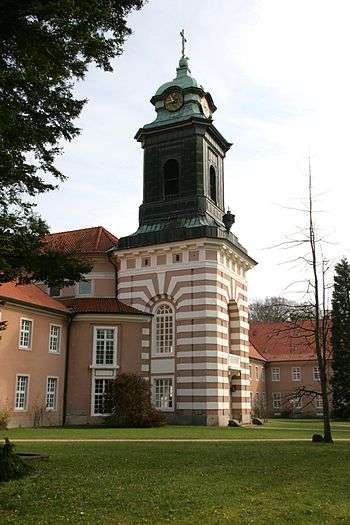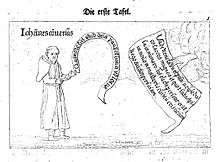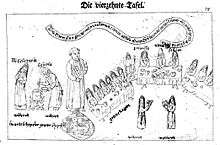Medingen Abbey
| Medingen Convent | |
|---|---|
| Medingen Convent St. Maurice | |
 | |
 Medingen Convent Location of Convent Medingen in Lower Saxony, Germany | |
| Coordinates: 53°05′26″N 10°33′55″E / 53.090601°N 10.565176°E | |
| Location | Medingen, Lower Saxony |
| Country | Germany |
| Denomination | Protestant Lutheran |
| Previous denomination | Catholic |
| Website |
www |
| History | |
| Founded | 1241 |
| Architecture | |
| Status | Convent |
| Functional status | Active |
Medingen Abbey or Medingen Convent (German: Kloster Medingen) is a former Cistercian nunnery. Today it is a residence for women of the Protestant Lutheran faith (German: Damenstift) near the Lower Saxon town of Bad Bevensen and is managed by the Monastic Chamber of Hanover (Klosterkammer Hannover).
History

A founding legend ascribes the convent's origins to a lay brother called Johannes; the convent's history from its founding to the election of abbess Margaretha Puffen was formerly depicted in a cycle of 15 painted wooden boards, that were destroyed in the fire of 1781; the only surviving copy is the affix in Johann Ludolf Lyßman's Historische Nachrichten (1772).[1] The legend has it that Johannes claimed divine guidance in his quest to build the new convent. The community was founded 1228 in Restorf am Höhbeck by Johannes and four nuns who joined him in Magdeburg, but the group did not stay there. For unknown reasons, they moved on to Plate near Lüchow and later Bohndorf, before they eventually settled in Altenmedingen, where the first buildings were consecrated on 24 August 1241.[2]
The military road passing through the convent yard presented an ever-present danger of attacks or arson, so the convent decided to move one last time, to the village of Zellensen, today's Medingen. The new church was consecrated on 24 August 1336.[3]
1479 saw the advent of the convent reforms under the influence of the devotio moderna. Many convents at that time did not follow the Cistercian rule very strictly; nuns were allowed to keep their belongings and keep in touch with their relatives once they joined the convent. The Cistercian order was re-established and the prioress Margarete Puffen was made an abbess in 1494.[4] After the reforms, a scriptorium became one of the focal points of the convent and to this day a large number of manuscripts found worldwide can be attributed to the sixteenth-century nuns of Medingen. Hymns (Leisen) noted down in these texts are still part of both Catholic and Protestant hymnbooks today, e.g. in the current German Protestant hymnal Evangelisches Gesangbuch EG 23 "Gelobet seist du, Jesu Christ", EG 100 "Wir wollen alle fröhlich sein" and EG 214 "Gott sei gelobet und gebenedeiet", even though they were wrongly dated to the 14th century by the music historian Walther Lipphardt.[5]

The Reformation attempted to be introduced in Medingen in 1524, was met with resistance from the nuns. They hid their confessor in the attic, publicly burned the Lutheran bible and almost faced the dissolution of the convent. In 1541, the Uelzen Landtag decided to ensure the economic security of Medingen and the five other convents nearby. This was in the nobility's interests, because their unmarried daughters could benefit from the livelihood and education befitting their status. In 1542, all of the convent's goods and earnings were confiscated and contact between the nuns and their family was prohibited. The abbess, Margareta von Stöterogge, did not give in to the demands of bringing all remaining property to Celle, but rather went to Hildesheim for two years, taking the convent's archive and valuables with her. It took her brother, Nikolaus von Stöterogge, to convince her finally to accept the communion under both forms.[6] Eventually, in 1554, the convent became Protestant and from then on, the Klosterordnung (convent order) was defined by the Landesherr or territorial lord.[7]
After the Reformation had been introduced, life changed drastically: The incumbents were now allowed to marry, but had to leave the convent when they did so. In 1605, they replaced the traditional Cistercian habit with an attire in accordance with the convent order introduced by Duke William in 1574. The Thirty Years' War left its mark on the convent and its surrounding area. A new convent order was introduced by Kurfürst (elector) George Louis in 1706.[8]
Most of the convent buildings were destroyed in a fire in January 1781, although valuable possessions like the archives and the abbesses' crosier from 1494 were able to be salvaged. The ruins were demolished in 1782 and the convent re-built in the early neoclassic style. Completed in 1788, the new buildings were consecrated on 24 August.[9]
List of heads of convent
| Name | From | Until |
|---|---|---|
| Helmerich | 1236? | 1240 |
| Nikolaus I | 1241 | 1249 |
| Johannes | 1261 | 1261 |
| Nikolaus II | 1261 | 1286 |
| Hartwig von der Sülze | 1286 | 1306 |
| Christian | 1306 | resigned 1326 |
| Ludolf von Lüneburg | 1326 | 1355 |
| Dietrich Bromes | 1355 | 1358 |
| Dietrich von Langlingen | 1359 | 1370 |
| Johannes Ostermann | 1370 | 1380 |
| Dietrich Brand (von Melle?) | 1380 | 1396 |
| Johannes Meyer | 1396 | 1416 |
| Lüdiger Tolner | 1416 | resigned 1446 |
| Ludolf Lützken | 1446 | 1464 |
| Dr iur utr Johannes Mahler | 1464 | 1467 |
| Tilemann von Bavenstedt | 1467 | 1494 |
| Ulrich von Bülow | 1494 | 1516 |
| Johann von Mahrenholtz | 1516 | 1516 |
| Bruno von Alten | 1516 | 1518 |
| Johann von Mahrenholtz | 1518 | 1529 |
| Name | From | Until |
|---|---|---|
| Imma I | 1263 | 1284 |
| Imma II | 1284 | 1315 |
| Imma (Irmgard) III | 1315 | 1323 |
| Imma IV Ruffen | 1323 | 1332 |
| Wigburg | 1327 | 1327 |
| Mechthild I von Meding | 1333 | 1343 |
| Elisabeth I von Bernowe | 1344 | 1366 |
| Alburg von dem Sande | 1368 | 1371 |
| Elisabeth II | 1376 | 1379 |
| Elisabeth III | 1379 | 1399 |
| Druda von Dageförde | 1399 | 1428 |
| Mechthild II Semmelbecker | 1428 | 1435 |
| Caecilia von dem Berge | 1435 | 1445 |
| Elisabeth IV Langendorf | 1445 | 1464 |
| Mechthild III von Römstedt | 1464 | 1479 |
| Margaretha I Puffen | 1479 | 1494, later abbess |
| Name | From | Until | Denomination |
|---|---|---|---|
| Margaretha I Puffen | 1494, former prioress | 1513 | Catholic |
| Elisabeth I von Elvern | 1513 | 1524 | Catholic |
| Margaretha II Stöterogge | 1524 | 1567 | Catholic |
| Getrud I von Töbing | 1567 | 1588 | Protestant Lutheran |
| Elisabeth II von Töbing | 1588 | 1630 | Protestant Lutheran |
| Anna I von Sarstedt | 1630 | 1635 | Protestant Lutheran |
| Margaretha III von Dassel | 1636 | 1667 | Protestant Lutheran |
| Margaretha IV von Dassel | 1667 | 1680 | Protestant Lutheran |
| Catharina Prigge | 1681 | 1706 | Protestant Lutheran |
| Clara Anna von Lüneburg | 1707 | 1719 | Protestant Lutheran |
| Anna von Laffert | 1720 | 1721 | Protestant Lutheran |
| Elisabeth Catharina von Stöterogge | 1722 | 1741 | Protestant Lutheran |
| Sophia Catharina von Meiseburg | 1741 | 1750 | Protestant Lutheran |
| Sibylla Hedewig von Laffert | 1751 | 1755 | Protestant Lutheran |
| Margaretha Elisabeth von Braunschweig | 1755 | 1793 | Protestant Lutheran |
| Luise Charlotta von Heimburg | 1793 | 1797 | Protestant Lutheran |
| Sophie Eleonore von Töbing | 1798 | 1810 | Protestant Lutheran |
| Rahel Charlotte von Töbing | 1810 | 1814 | Protestant Lutheran |
| Luise Amalie von Wallmoden | 1814 | 1825 | Protestant Lutheran |
| Auguste von Töbingen | 1826 | 1849 | Protestant Lutheran |
| Ottilie von Brömbsen | 1850 | 1906 | Protestant Lutheran |
| Auguste von Schmidt-Phiseldeck | 1907 | 1917 | Protestant Lutheran |
| Emma von Laffert | 1917 | 1930 | Protestant Lutheran |
| Luise von Brömbsen | 1931 | 1943 | Protestant Lutheran |
| Ilse von Döring | 1944 | 1972 | Protestant Lutheran |
| Helge von Bülow | 1972 | 1989 | Protestant Lutheran |
| Gisela Rothbarth | 1989 | 1999 | Protestant Lutheran |
| Monika von Kleist | 1999 | 2012 | Protestant Lutheran |
| Dr. Kristin Püttmann | since 2012 | Protestant Lutheran |
Cultural heritage
A large number of medieval manuscripts were produced in Medingen, 44 of which have survived and are conserved all over the world. The nuns enhanced the liturgy written in Latin with Low German prayers and songs, producing unique compilations of illuminated texts that were important to them as well as the noblewomen in the surrounding areas.[11]
Furthermore, the brewery (German: Brauhaus), built in 1397, survived the fire of 1781 and can still be seen today. It attests to the fact that the convent was originally built in the Brick Gothic style.[12]
References
- ↑ Lyßmann, Johann Ludolf, gewesenen Predigers zu Closter Meding, und nachherigen Superintendenten zu Fallersleben: Nachricht von dem Ursprunge, Anwachs und Schicksalen des im Lüneburgischen Herzogthum belegenen Closters Meding, dessen Pröbsten, Priorinnen und Abbatißinnen, auch fürnehmsten Gebräuchen und Lutherischen Predigern &c. nebst darzu gehörigen Urkunden und Anmerkungen bis auf das Jahr 1769 fortgesetzt. Mit Kupfern. Halle, 1772.
- ↑ Vogtherr, Thomas: Medingen. In: Dolle, Josef (ed.): Niedersächsisches Klosterbuch. Vol. 3, Bielefeld 2012, p 1044.
- ↑ Der Umzug in das heutige Medingen / Moving to today's Medingen at www.kloster-medingen.de. Retrieved 4 June 2013
- ↑ at www.inschriften.net. Retrieved on 5 June 2013
- ↑ Achten, Gerard (1987). De Gebedenboeken van de Cistercienserinnenkloosters Medingen en Wienhausen in: Miscellanea Neerlandica 3 (= FS Jan Deschamps), pp. 173–188.
- ↑ Letter by Nikolaus Stöteroggen to his sister Margarete Stöteroggen written June 1554, published in the collection of charters and letters of Medingen Abbey by Homeyer (2006) No. 705
- ↑ Die Reformation / The Reformation at kloster-medingen.de. Retrieved on 5 June 2013
- ↑ Das Leben nach der Evangelisierung / Life after the Reformation at kloster-medingen.de. Retrieved on 5 June 2013
- ↑ Der Brand 1781 und der Wiederaufbau / The fire of 1781 and Reconstruction at kloster-medingen.de. Retrieved on 5 June 2013
- ↑ Vogtherr, Thomas: Medingen. In: Dolle, Josef (ed.): Niedersächsisches Klosterbuch. Vol. 3, Bielefeld 2012, p 1049.
- ↑ Medingen Manuscripts, a project to digitise the manuscripts produced in Medingen. Retrieved on 2 July 2016
- ↑ Historisches Brauhaus und ehemaliges Knechtshaus / Historic Brewery and Former Servants' House at www.kloster-medingen.de. Retrieved on 4 June 2013
Further reading
- Achten, Gerard: De Gebedenboeken van de Cistercienserinnenkloosters Medingen en Wienhausen, in: Miscellanea Neerlandica 3 (= FS Jan Deschamps), 1987, pp. 173–188.
- Brohmann, Friedrich: Geschichte von Bevensen und Kloster Medingen, 1928.
- Hascher-Burger, Ulrike / Lähnemann, Henrike: Liturgie und Reform in Kloster Medingen. Edition und Untersuchung des Propst-Handbuchs Oxford, Bodleian Library, MS. Lat. liturg. e. 18 (Spätmittelalter und Reformation. Neue Reihe), Tübingen: Mohr Siebeck, 2013 (in press).
- Heutger, Nicolaus Carl: Kloster Medingen in der Lüneburger Heide, in: 'Cistercienser Chronik.' Forum für Geschichte, Kunst, Literatur und Spiritualität des Mönchtums, Vol. 101 (1994), pp. 15–18
- Homeyer, Joachim: 750 Jahre Kloster Medingen. Kleine Beiträge zur frühen Klostergeschichte. (Schriften zur Uelzener Heimatkunde, hg. v. Hans E. Seidat, H. 3), Uelzen, 1978.
- Homeyer, Joachim: Kloster Medingen, die Gründungslegende und ihre historischen Elemente, in: Jahrbuch der Gesellschaft für niedersächsische Kirchengeschichte 79 (1981), pp. 9–60.
- Homeyer, Joachim (Hg.): Kloster Medingen 1788 – 1988, 200 Jahre Neubau. Kleine Beiträge zum Jubiläum. Uelzen, 1988
- Homeyer, Joachim: Urkundenbuch des Klosters Medingen. Hahn, Hannover 2006, ISBN 978-3-7752-6033-6.
- Homeyer, Joachim: 500 Jahre Äbtissinnen in Medingen (Schriften zur Uelzener Heimatkunde, hg.v. von Horst Hoffmann, H. 11), Uelzen, 1994.
- Krüger, Nilüfer: Niederdeutsches Osterorationale aus Medingen, in: FS für Horst Gronemeyer zum 60. Geburtstag, hg.v. Herald Weigel, Herzberg, 1993, pp. 179–201.
- Lähnemann, Henrike: An dessen bom wil ik stighen. Die Ikonographie des Wichmannsburger Antependiums im Kontext der Medinger Handschriften, in: Oxford German Studies 34 (2005), pp. 19–46.
- Lähnemann, Henrike/ Linden, Sandra: Per organa. Musikalische Unterweisung in Handschriften der Lüneburger Klöster, in: Dichtung und Didaxe. Lehrhaftes Sprechen in der deutschen Literatur des Mittelalters, Berlin/New York, 2009, p. 397-412.
- Lähnemann, Henrike: Die Erscheinungen Christi nach Ostern in Medinger Handschriften, in: Medialität des Heils im späten Mittelalter, ed. by Carla Dauven-van Knippenberg, Cornelia Herberichs, and Christian Kiening, Chronos, 2009 (Medienwandel – Medienwechsel – Medienwissen 10), pp. 189–202.
- Lähnemann, Henrike: Schnipsel, Schleier, Textkombinatorik. Die Materialität der Medinger Orationalien, in: Materialität in der Editionswissenschaft, ed. by Martin Schubert, Tübingen, 2010 (Beihefte zu editio), pp. 135–146.
- Lyßmann, Johann Ludolf, gewesenen Predigers zu Closter Meding, und nachherigen Superintendenten zu Fallersleben: Historische Nachricht von dem Ursprunge, Anwachs und Schicksalen des im Lüneburgischen Herzogthum belegenen Closters Meding, dessen Pröbsten, Priorinnen und Abbatißinnen, auch fürnehmsten Gebräuchen und Lutherischen Predigern &c. nebst darzu gehörigen Urkunden und Anmerkungen bis auf das Jahr 1769 fortgesetzt. Mit Kupfern. Halle, 1772. (Digital version)
- Stork, Hans-Walter: Die mittelalterlichen Handschriften des ehemaligen Zisterzienserinnenklosters Medingen zur Zeit der Klosterreform im 15. Jahrhundert und in nachreformatorischer Zeit., in: Otte, Hans (ed.): Evangelisches Klosterleben. Studien zur Geschichte der evangelischen Klöster und Stifte in Niedersachsen, Göttingen 2013, pp. 337 – 360.
- Vogtherr, Thomas: Medingen, in: Dolle, Josef (ed.): Niedersächsisches Klosterbuch. Verzeichnis der Klöster, Stifte, Kommenden und Beginenhäuser in Niedersachsen und Bremen von den Anfängen bis 1810. Marienthal bis Zeven (Vol. 3), Bielefeld 2012, pp. 1044–1050.
- Wehking, Sabine: Die Inschriften der Lüneburger Klöster. Ebstorf, Isenhagen, Lüne, Medingen, Walsrode, Wienhausen (Die Deutschen Inschriften 76 = Die deutschen Inschriften: Göttinger Reihe 13) Wiesbaden 2009.
External links
| Wikimedia Commons has media related to Kloster Medingen. |
- Website of the Convent
- Article on Medingen on the Bad Bevensen website
- Article on Medingen on the Historisches Bevensen e.V. website (Historical Bevensen Association)
- Artikle on Medingen on the Lüneburg Heath website
- Article on Medingen on the NDR website
- on the Medingen Manuscripts and extensive bibliography
- Blog entry on a Medingen manuscript now in the Bodleian Library of the University of Oxford
